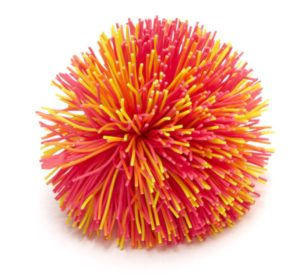Fidget Toys are Centuries Old!
The tradition of fidgeting dates back to ancient times. Ali Jaffe’s recent article, “Quit Worrying, Fidget Toys have been Around Forever,” takes a spin through the ages, looking at the fidget toys that have captured our attention in bygone years. She cites Drs. Katerine Isbister and Michael Karlesky who have conducted research about why and how we fidget in their article, “Understanding Fidget Widgets: Exploring the Design Space of Embodied Self-Regulation.” Karlesky explains, “We are hard-wired for self-regulation enacted through tangible, tactile sensory experiences.” In other words, we look for ways to soothe ourselves.
Ancient Fidget Toys
Some of the earliest fidget toys Jaffe mentions include these:
Baoding balls – a.k.a. Yin Yang Balls or Meditation Balls. You roll this pair of metal balls over and over in the palm of your hand. Developed by the Ming Dynasty in China circa 1368-1644, you can still purchase Baoding Balls around the world!
Worry Beads (or Greek kompoloi) consist of a string of beads manipulated with one or two hands and used to pass time. Unlike the similar prayer beads, used in many religious traditions, worry beads have no religious or ceremonial purpose.
Prayer Beads (Mala, Rosary, Prayer Ropes) reputedly originate in the Eastern religions in India in the 3rd century BC (admittedly, I haven’t yet verified this claim).
Modern Fidget Toys
More recently, TIME reporter Allie Townsend assembled a list of the 100 most influential toys from the 1920s to 2000s. A quick scan through this list of favorite toys of the ages reveals a bunch that remain popular today!

Koosh Ball, $6.75BUY NOW
Longtime Favorite Fidget Toys
- Slinky – (1940s) sure, the slinky is said to be able to step down the stairs, but I’d assert that the ability to manipulate this giant spring between two hands is what’s accounted for it’s continued popularity. Slinky’s and generic “Springs” come in a variety of materials and sizes.
- Silly Putty (1950s) – the malleable, stretchable putty was also able to pickup newsprint writing, but has continued to evolve as new putty manufacturers have added playful colors and effects. Crazy Aaron Putty, Theraputty, and Brain Putty are brands you will find readily available today.
- Gumby (1955) – the bendy green guy, and his buddy Pokey, have been favorites since their movie debut in 1953. They remain favorites to bend, pull and shape.
- Play-Doh (1950s) – starting off as a mashable wallpaper cleaner in the early 1950s, developer Joe McVicker quickly learned that it was better as a kids’ toy than a cleaning product. By 1980, 8 colors were available and remain a favorite for adults and children worldwide.
- Rubics Cube (mid-1970s) – the Cube gained it’s popularity as a brain puzzle, however it has remained a fixture in the toys stores. I’m guessing it’s only in part because people love the challenge. They also love occupying their fingers even when they’re not solving the puzzle.
- Koosh (late 1980s) – the hundreds of rubber strands on the Koosh Ball have made this product a continued success as both a tossable ball and a fidget toy, because it’s easy to catch, won’t hurt you, and is so pleasant to handle.
Remember these?
- Buckyballs (1996) – this block of tiny magnetic balls was an immediate success as a fidget and desk toy, but was taken off the market shortly after its launch because the small magnets proved to be extremely dangerous if ingested by children.
- Troll Doll – a Danish Woodworker, Thomas Dam made the first Troll Doll in 1959. The brilliantly colored, soft hair, made these a rapid success.
- Stretch Armstrong (1970s) – this was marketed as the “unbreakable toy,” that could withstand bending, pulling, twisting, then revert back to it’s normal size without a mark. Pull Stretch’s limbs to four times their natural span! Stretch is still available today!
Fidgeting without Fidget Toys
In addition, to these familiar toys, you’ve likely seen girls twirling their hair, lifeguards looping their whistle endlessly around their finger, or men fussing with their pocket change. Examples of people fidgeting are endless. Perhaps quitting smoking is so hard because in addition to the nicotine addiction) it gives people something to do with their hands. If you take away the cigarette, a “patch” might not be enough. Try, too, to keep a fidget toy on hand to occupy your fingers and reduce stress!
Fidget Spinners and Fidget Cubes certainly took over the world for a while. But, who knows what will be next? As fidgeting grows in popularity, brand new fidget toys continue to hit the market! Check out Trainers Warehouse fidget toys here.
- +52
Comments

